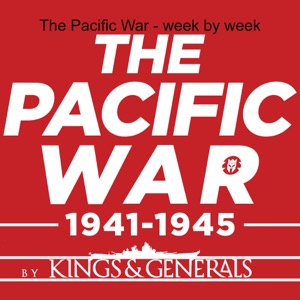- 163 - Pacific War Podcast - Aitape-Wewak Campaign - December 31 - January 7 - , 1944
The Pacific War - week by week - A podcast by kingsandgenerals - Tuesdays

Last time we spoke about the Victory at Leyte. In the Ormoc Valley, General Krueger's forces pushed the Japanese into a retreat toward Palompon. As the Americans advanced, they faced entrenched enemy positions and challenging terrain. On Christmas Day, the 77th Division successfully captured Palompon, cutting off the Japanese's main route. General Suzuki, forced to relocate his headquarters, prepared for a counteroffensive. Despite fierce resistance, American troops continued to push forward, eliminating remaining Japanese units and securing strategic positions along the coast as the year closed. As General Eichelberger's 8th Army took command of Leyte Island, the 77th Division relieved other units in preparation for future operations. Meanwhile, American forces faced fierce resistance while securing strategic positions on Samar and Mindoro. Despite enemy air assaults, they successfully disrupted Japanese plans, including a failed counter-landing. In Bougainville, Australian troops engaged in intense fighting, capturing Pearl Ridge after fierce battles. Their victory provided a crucial vantage point for future offensives, marking a significant moment in the campaign. This episode is the Aitape-Wewak Campaign Welcome to the Pacific War Podcast Week by Week, I am your dutiful host Craig Watson. But, before we start I want to also remind you this podcast is only made possible through the efforts of Kings and Generals over at Youtube. Perhaps you want to learn more about world war two? Kings and Generals have an assortment of episodes on world war two and much more so go give them a look over on Youtube. So please subscribe to Kings and Generals over at Youtube and to continue helping us produce this content please check out www.patreon.com/kingsandgenerals. If you are still hungry for some more history related content, over on my channel, the Pacific War Channel you can find a few videos all the way from the Opium Wars of the 1800’s until the end of the Pacific War in 1945. As previously discussed, General Dunckel’s task force successfully invaded Mindoro. Despite recent enemy efforts to reclaim control of the island, the Americans managed to establish airfields that enabled land-based aircraft to target specific locations on Luzon while also safeguarding the assault and resupply ships heading to Lingayen Gulf. This location was chosen because it had direct access to Luzon's key military objective, the Central Plains-Manila Bay region, and it featured the best and most extensive landing beaches on the island. With General Eichelberger’s 8th Army taking charge of Leyte and Mindoro, General Krueger’s 6th Army was assigned to capture and secure a beachhead at Lingayen Gulf and then advance south through the Central Plains to seize Manila and open Manila Bay. Furthermore, air and logistical bases would be established on Luzon to support future operations against Japan, and the legitimate government of the Philippine Commonwealth would be reinstated in its capital. For Operation Mike I, the reconquest of Luzon island, the Southwest Pacific's intelligence estimates concerning Japanese strengths, dispositions, capabilities, and intentions on Luzon were reasonably accurate from the start of planning. The abundance of information must be attributed in large measure to the efforts of guerrillas on Luzon, an island that was becoming a veritable hotbed of guerrilla resistance, both American-led and Filipino-led. Carefully nurtured by MacArthur's headquarters, especially after mid-1943, the guerrilla organizations had grown steadily in strength and effectiveness not only as sabotage units but also as valuable sources of information. The Leyte invasion in October 1944 gave great encouragement to the guerrillas, who redoubled their efforts in preparation for the invasion of Luzon, which they realized could not be too far off. Throughout 1944 supplies of all types had been sent to the guerrillas, first by submarine and later by air
